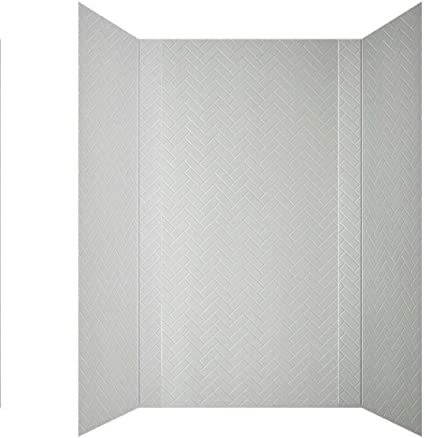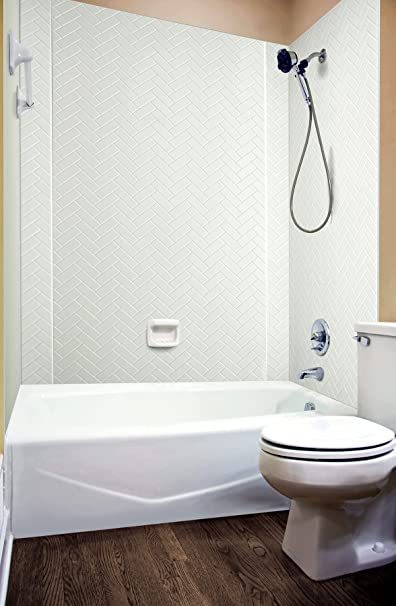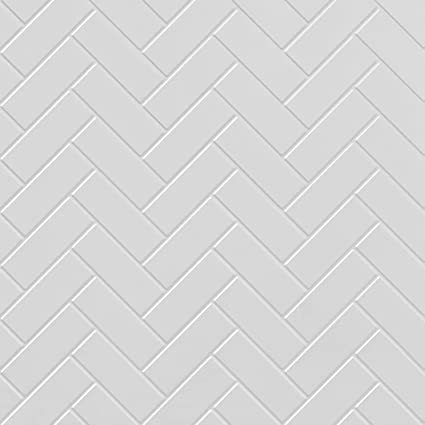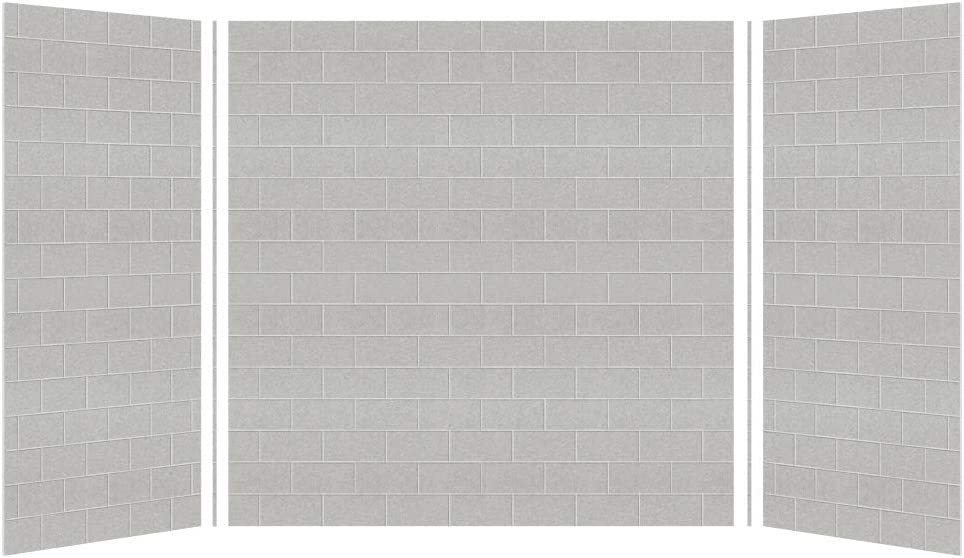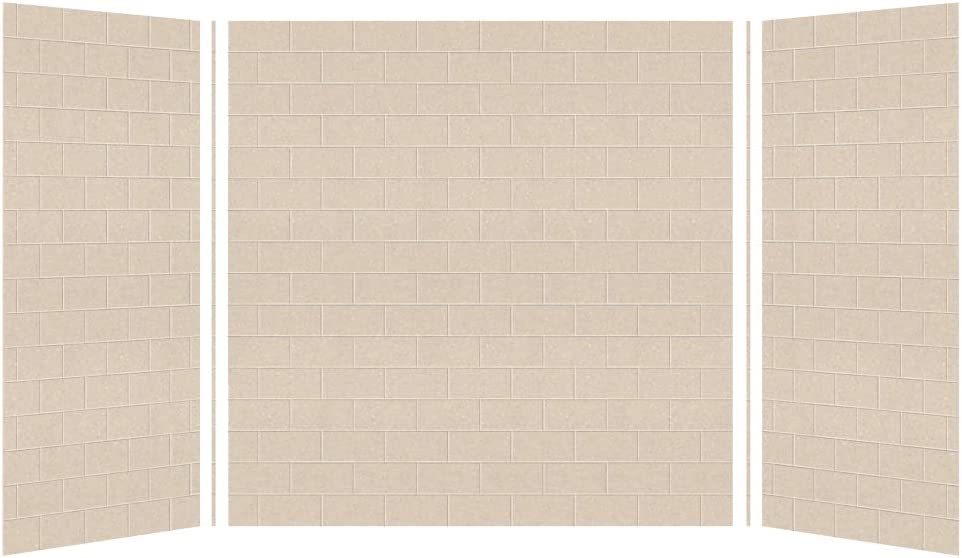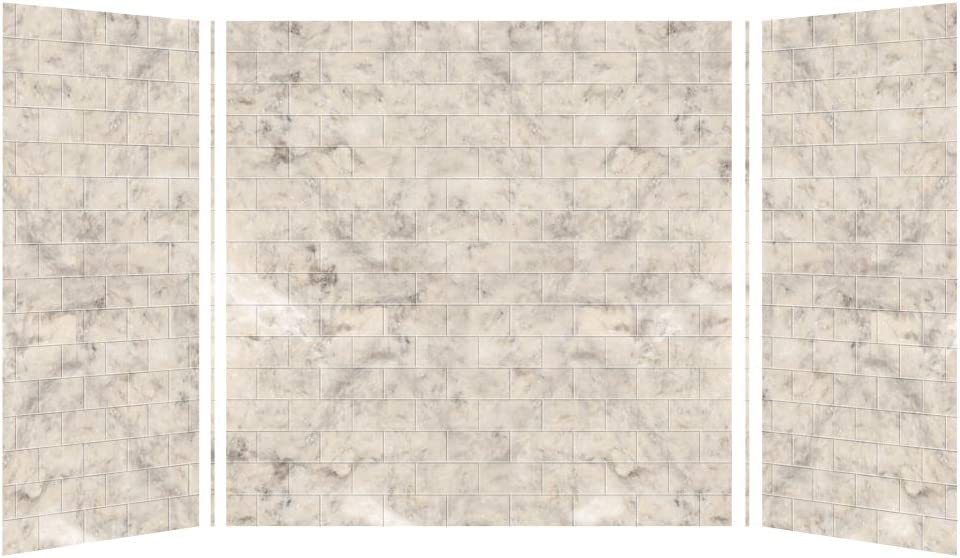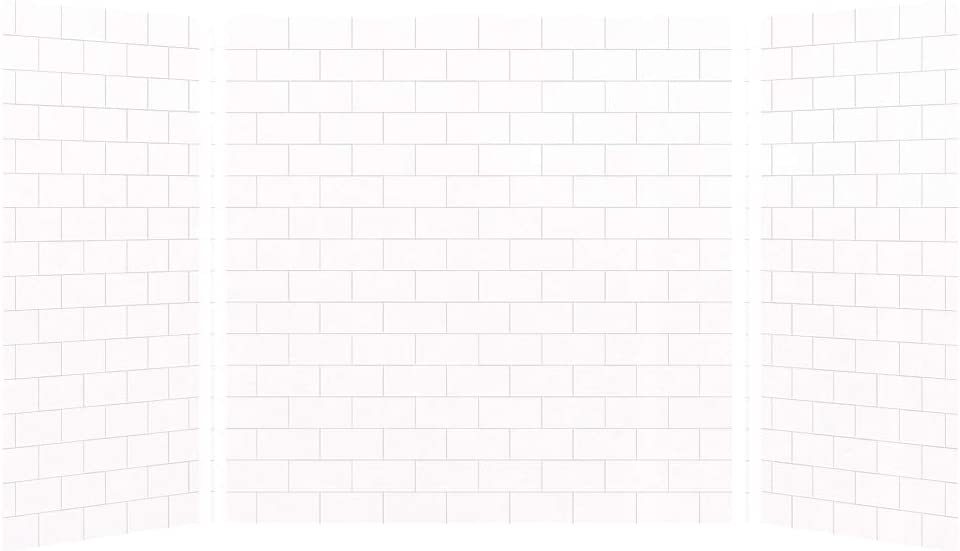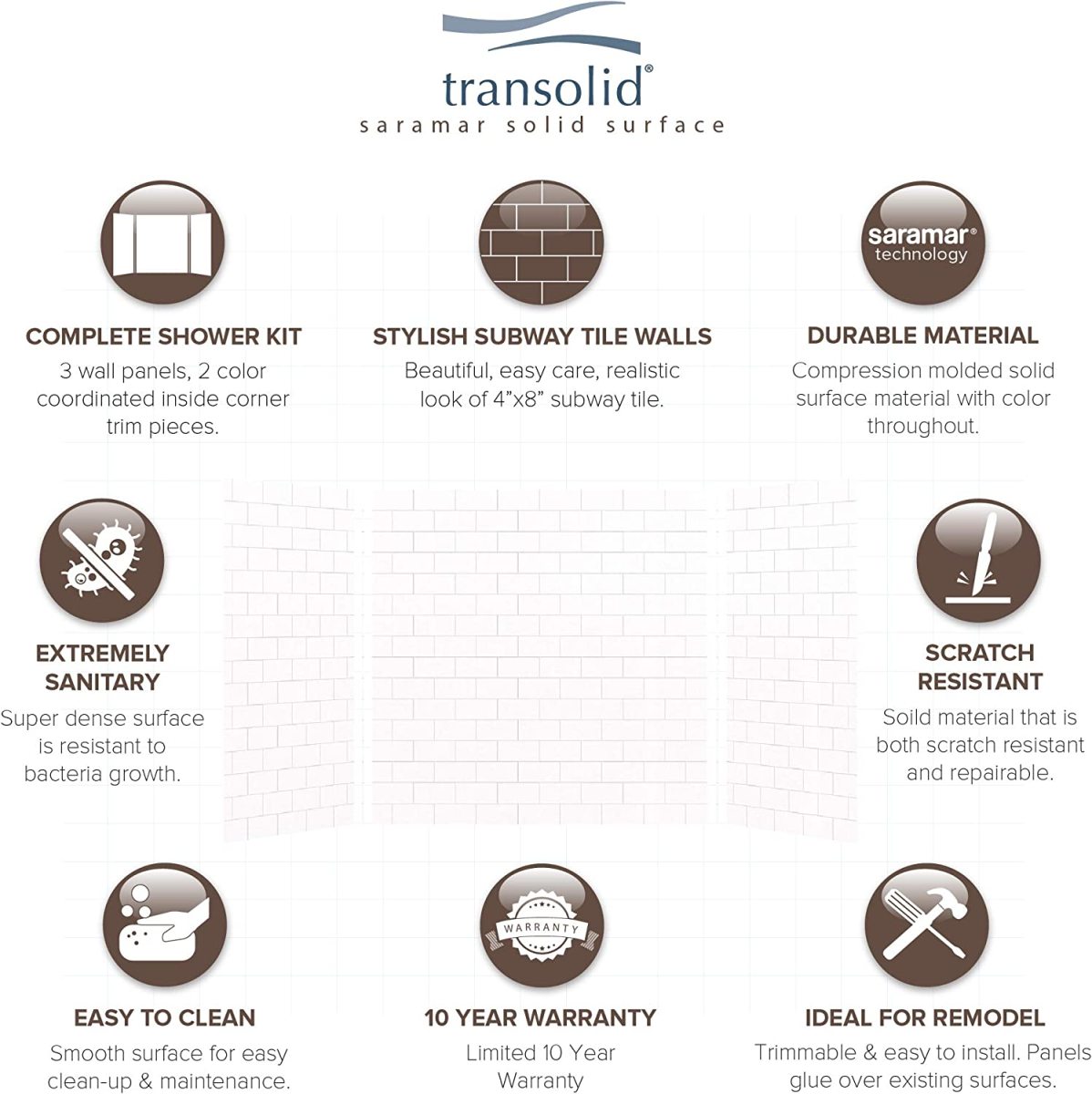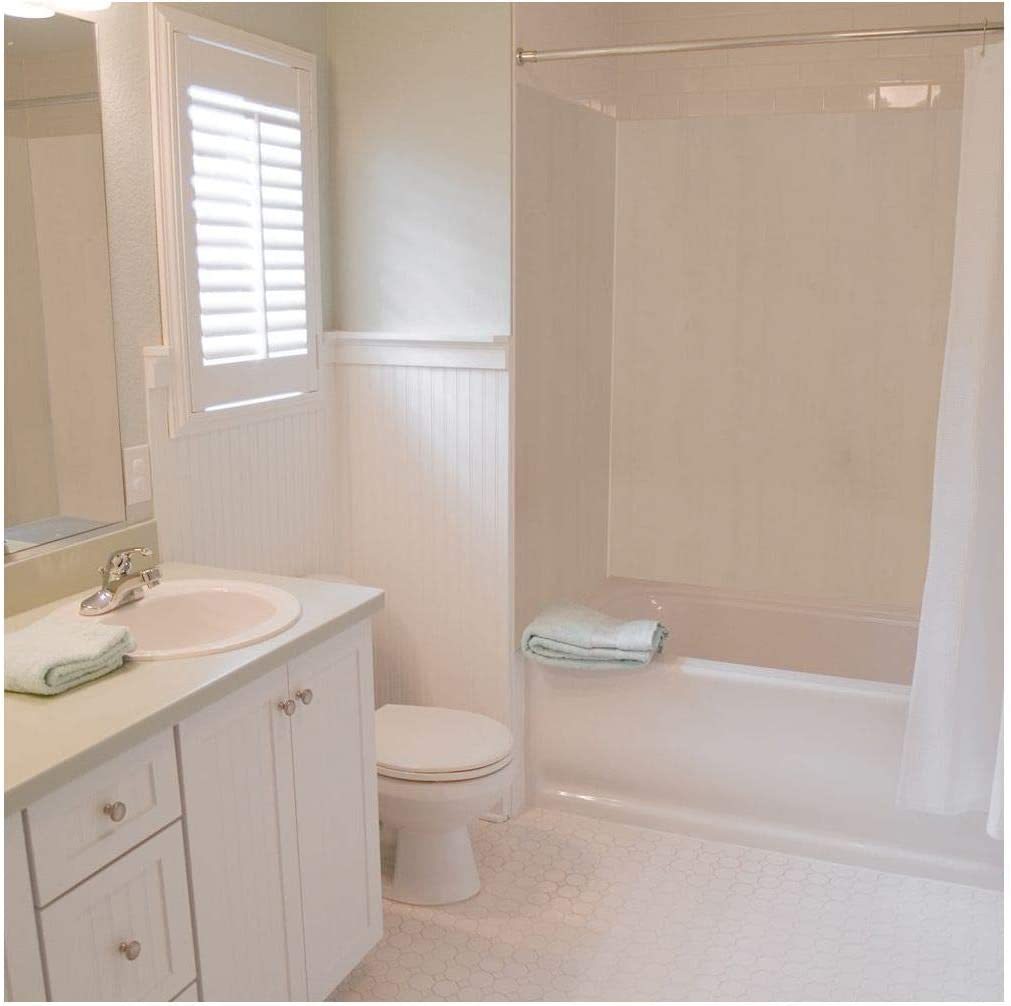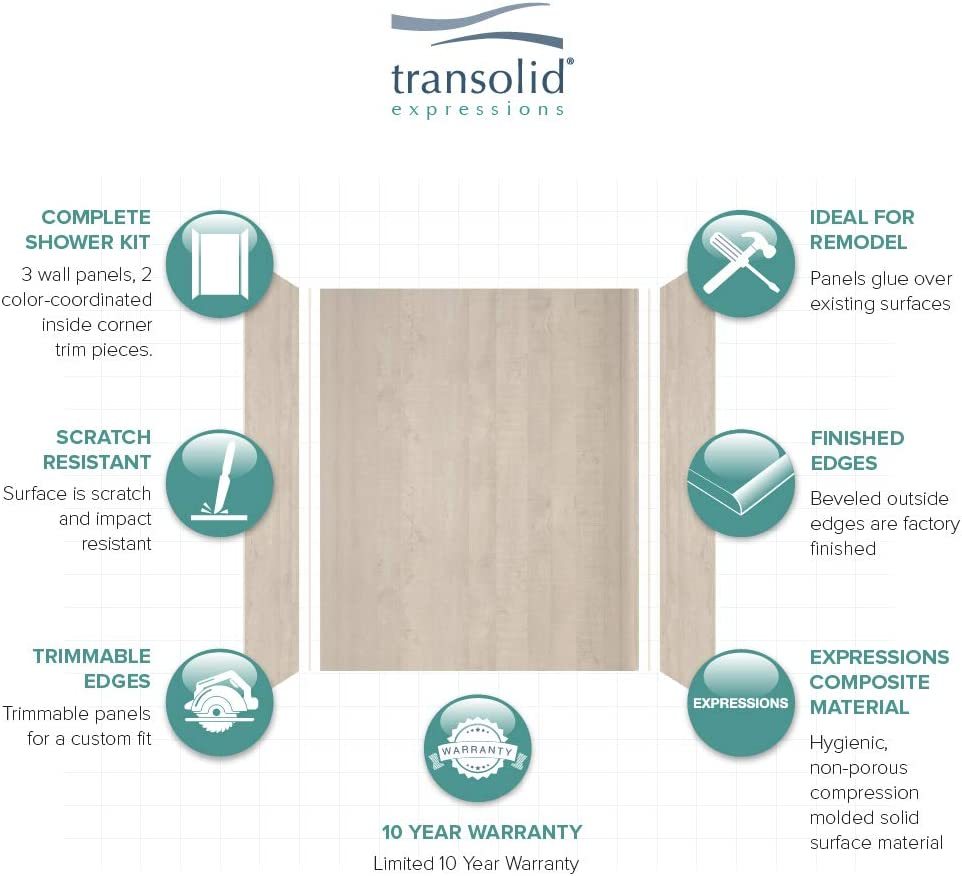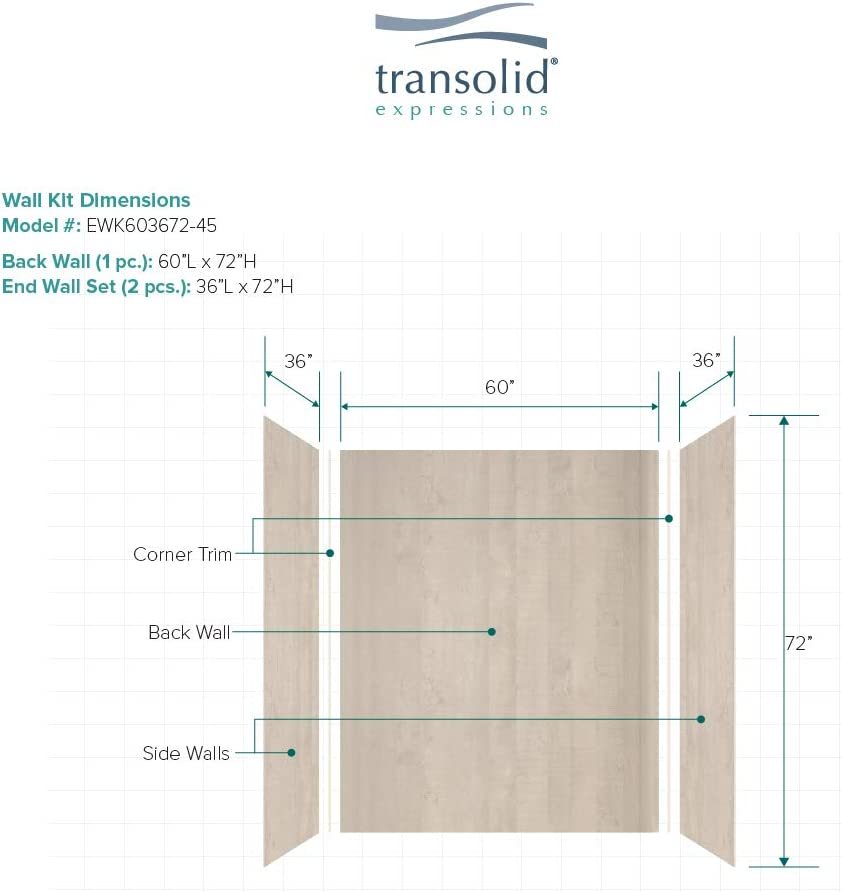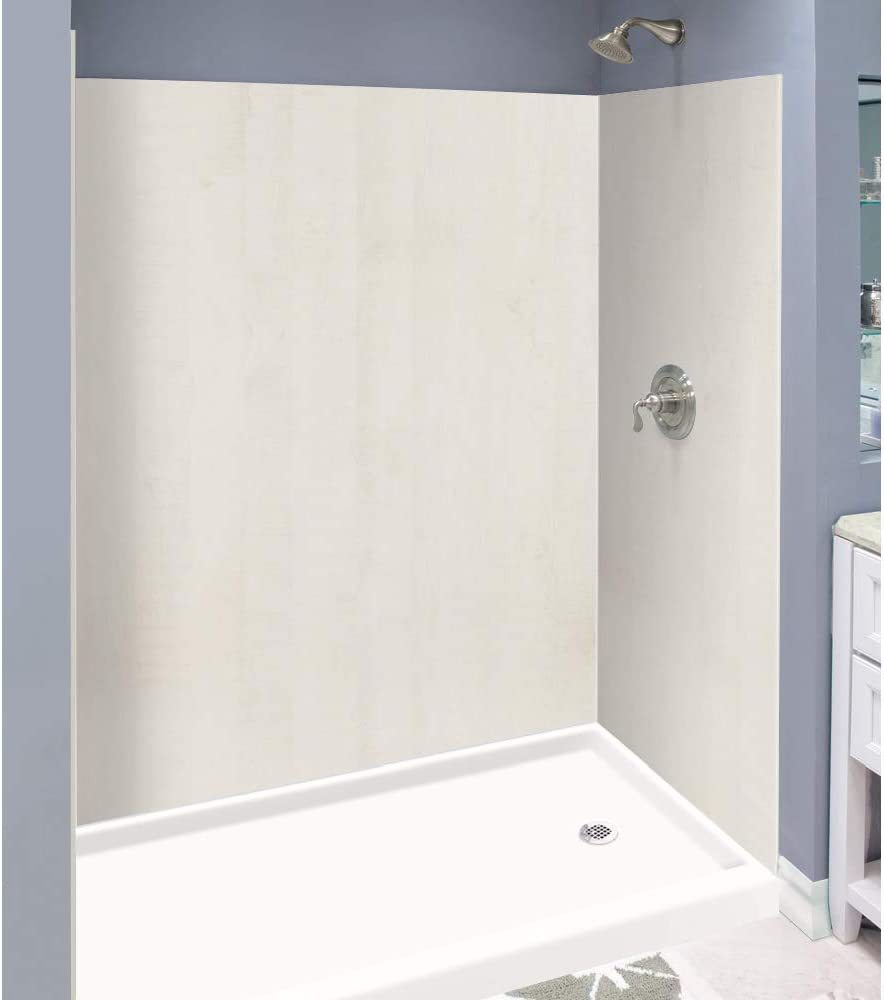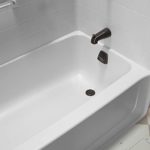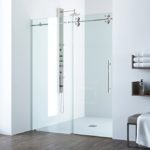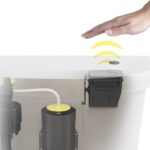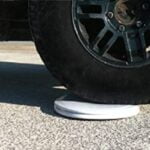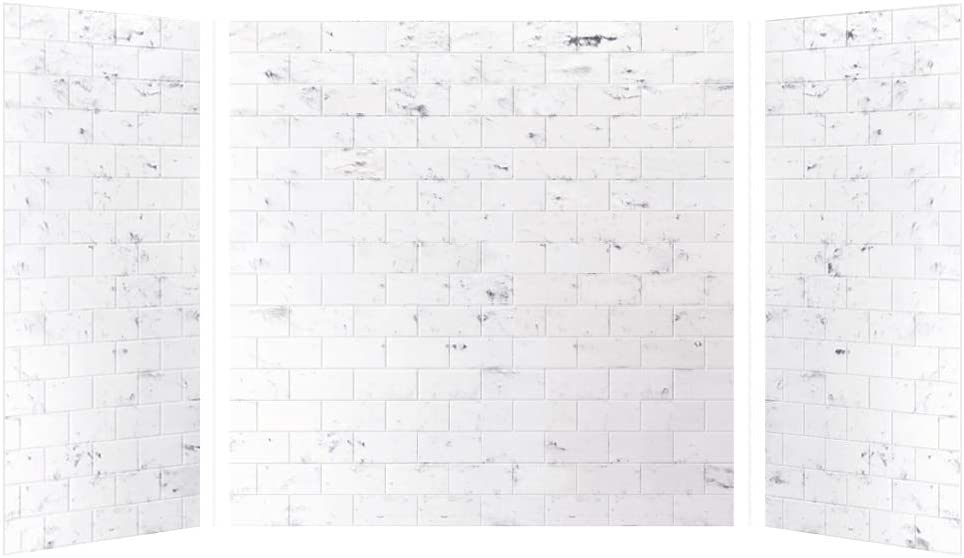
The Best Bathtub Shower Wall
I. Introduction
When it comes to renovating a bathroom, the walls around the bathtub or shower can be a crucial design element. While traditional options like tile or paint may seem like the go-to choices, bathtub and shower wall panels offer a host of benefits that make them a popular choice among homeowners. In this article, we’ll explore the world of bathtub and shower wall panels, answering common questions you may have about these innovative products. We’ll cover everything from installation to materials and costs, so you can make an informed decision about whether wall panels are right for your bathroom renovation.
II. What Can I Put on the Wall Around My Bathtub?
If you’re looking to update the walls around your bathtub, there are several options to consider. You could go with traditional choices like tile, wallpaper, or paint. However, for a low-maintenance, waterproof solution, bathtub and shower wall panels are an excellent choice.
Wall panels are made from a variety of materials, including acrylic, PVC, and fiberglass. They come in a range of styles and colors, so you can easily find an option that matches your bathroom decor. Unlike tile, which requires grout that can stain and collect mildew, wall panels have no seams, making them easy to clean and maintain.
In addition to their practical benefits, wall panels are also aesthetically pleasing. They can give your bathroom a modern, sleek look, or a classic, timeless feel. Whether you want a bright pop of color or a calming neutral, wall panels can achieve the look you want.
So, when it comes to what you can put on the wall around your bathtub, wall panels are a standout option. They offer a durable, low-maintenance surface that will look great for years to come.
III. What Are the Walls Around a Bathtub Called?
The walls around a bathtub are often referred to as the “bathtub surround.” This term encompasses any material or structure that covers the walls around a bathtub, from traditional tile to modern wall panels.
There are two main types of bathtub surrounds: built-in and freestanding. Built-in surrounds are integrated into the bathtub itself and are usually made of the same material, such as porcelain or fiberglass. Freestanding surrounds, on the other hand, are separate from the bathtub and can be made from a variety of materials, including tile, stone, or wall panels.
Built-in surrounds are a popular choice because they are easy to clean and maintain. They also provide a seamless look between the bathtub and surrounding walls. However, if you’re looking for a more customizable option, freestanding surrounds may be the way to go. They allow for more design flexibility and can be easily replaced if damaged or outdated.
No matter which type of bathtub surround you choose, it’s important to select a material that is durable, waterproof, and easy to clean. Wall panels are a great option because they meet all of these criteria, while also providing a modern, stylish look.
IV. How Do You Install Wall Panels in a Bathtub?
Installing bathtub wall panels is a relatively simple process that can be done in just a few steps. Here’s a quick guide on how to install wall panels in a bathtub:
- Measure the walls: Measure the length and height of the walls around your bathtub to determine how many panels you’ll need. Be sure to account for any cutouts, like for the faucet or showerhead.
- Cut the panels: Use a saw or utility knife to cut the panels to the correct size. Be sure to wear protective gear, like gloves and goggles, when cutting the panels.
- Apply adhesive: Apply a bead of adhesive along the back of the panel, making sure to cover the entire surface. Be sure to use an adhesive specifically designed for wall panels.
- Position the panels: Position the panel against the wall, making sure to align it with any cutouts or other panels. Apply pressure to the panel to ensure it is firmly adhered to the wall.
- Repeat: Repeat the process with the remaining panels, making sure to leave a small gap between each panel to allow for expansion.
- Finish: Once all of the panels are installed, use caulk to seal any gaps between the panels and the bathtub or other fixtures.
When installing wall panels, it’s important to take your time and follow the manufacturer’s instructions carefully. Be sure to work in a well-ventilated area and wear protective gear as needed. Additionally, if you’re installing wall panels over existing tile, be sure to thoroughly clean and prep the surface before applying adhesive. With the right tools and techniques, you can achieve a professional-looking installation that will last for years to come.
V. What Is the Best Material for Bathtub Surrounds?
When it comes to choosing the best material for your bathtub surround, there are a few options to consider. Here’s a breakdown of the most common materials used for bathtub surrounds:
- Acrylic: Acrylic is a popular choice for bathtub surrounds because it is durable, easy to clean, and comes in a variety of colors and styles. It is also lightweight, making it easier to install. However, acrylic can scratch easily and may not be as long-lasting as other materials.
- Fiberglass: Fiberglass is another common material for bathtub surrounds. It is lightweight and affordable, but not as durable as some other materials. Fiberglass can crack over time, and may not hold up as well in high-traffic areas.
- PVC: PVC, or polyvinyl chloride, is a newer material on the market for bathtub surrounds. It is resistant to water damage and mildew, making it a good choice for bathrooms. It is also lightweight and easy to install. However, PVC may not be as durable as other materials and may not hold up as well over time.
Based on these options, we recommend acrylic as the best material for bathtub surrounds. While it may not be as long-lasting as some other materials, its durability and ease of maintenance make it a great choice for most homeowners. Plus, with a wide range of colors and styles to choose from, it’s easy to find an acrylic surround that fits your bathroom’s design.
VI. Can You Use Wall Panels Around a Bath?
Yes, wall panels are a great option for both bathtubs and showers. They are easy to install and provide a waterproof surface that is low-maintenance and durable. Additionally, wall panels come in a variety of colors and styles, making it easy to find a design that fits your bathroom’s aesthetic. Whether you’re looking to update an existing bathtub or installing a new shower, wall panels can be a great choice for the walls around your bath.
VII. What Is the Cheapest Option for Bathroom Walls?
When it comes to covering bathroom walls, there are a few options to consider, including paint, wallpaper, tile, and wall panels. Of these options, paint is typically the most affordable choice. A fresh coat of paint can quickly transform a bathroom and is easy to apply yourself. Wallpaper is also an option, but it can be more difficult to install and may not hold up as well in areas with high humidity.
Tile is another popular option for bathroom walls, but it can be more expensive than other choices. The cost of the tile itself, as well as the installation, can add up quickly. While tile can be a durable and long-lasting choice, it may not be the most cost-effective option in the long run.
Looking to waterproof your tub or shower surround? Check out our DIYer’s guide for step-by-step instructions and helpful tips: Waterproofing Tub/Shower Surround: A DIYer’s Guide.
Wall panels, on the other hand, can be a more cost-effective choice in the long run due to their low maintenance and durability. While the upfront cost may be higher than paint or wallpaper, wall panels are resistant to water damage and require very little upkeep. This means that they will not need to be replaced as often as other options, making them a more affordable choice over time. Additionally, wall panels are available in a wide range of colors and styles, making it easy to find a design that fits your budget and aesthetic.
VIII. What Are Bathroom Wall Panels Called?
Bathroom wall panels are a type of wall covering that is designed specifically for use in bathrooms and other wet areas. These panels are made from a variety of different materials, including PVC, acrylic, and fiberglass, and are available in a wide range of colors and styles.
Bathroom wall panels are sometimes referred to as shower wall panels or bathtub wall panels, depending on their intended use. They are designed to provide a waterproof and low-maintenance surface that is both durable and attractive.
There are several types of bathroom wall panels available, including those that are designed to mimic the look of tile or stone, as well as those that have a smooth or textured finish. Some panels are designed to be installed directly over existing walls, while others require a substrate or backing board to be installed first.
When choosing bathroom wall panels, it is important to consider factors such as durability, ease of installation, and design. By choosing the right type of wall panel for your bathroom, you can create a space that is both functional and stylish.
IX. What Is a Bath Side Panel?
A bath side panel is a piece of material that is used to cover the side of a bathtub. It is designed to provide a finished look to the bathtub and to conceal any plumbing or hardware that may be located underneath.
Bath side panels are typically made from a variety of materials, including acrylic, PVC, and wood. They are available in a wide range of colors and styles to match the decor of your bathroom.
In addition to providing a finished look to your bathtub, a bath side panel can also help to protect the walls around your bathtub from water damage. They are easy to install and can be customized to fit the size and shape of your bathtub.
Overall, a bath side panel is a practical and stylish solution for covering the side of your bathtub and creating a cohesive look in your bathroom.
X. What Is a Tub Wrap?
A tub wrap is a type of bathtub refinishing technique that involves covering an existing bathtub with a new surface. The process involves applying a new surface material, such as an acrylic or PVC panel, over the existing bathtub.
Tub wraps are a cost-effective way to update the look of an existing bathtub without having to replace it entirely. They are also a good option for repairing minor damage or surface imperfections, such as chips or cracks.
Tub wraps are available in a variety of colors and styles, allowing you to customize the look of your bathtub to match your bathroom decor. They are easy to install and can typically be completed in just a few hours.
Overall, a tub wrap is a practical and affordable solution for updating the look of your bathtub and improving the overall appearance of your bathroom.
XI. What Are Cheap Tub Surrounds Made Of?
Cheap tub surrounds are typically made of materials such as PVC and fiberglass. PVC panels are lightweight, easy to install, and can be cut to fit the exact size of your bathtub. They are also waterproof, making them ideal for use in wet areas such as bathrooms. PVC panels come in a variety of colors and styles, so you can choose the look that best matches your bathroom decor.
Fiberglass tub surrounds are another affordable option. They are made of a durable, lightweight material that is resistant to mold and mildew. Fiberglass surrounds can be installed quickly and easily, making them a good choice for DIY projects. They are also available in a range of colors and styles.
While these materials may not be as durable as other options such as acrylic, they offer a cost-effective solution for those on a tight budget. Keep in mind that cheaper materials may not last as long as more expensive options, so it is important to consider your long-term needs when choosing a tub surround material.
XII. What Is the Easiest Tub Surround to Install?
When it comes to ease of installation, wall panels are often the most convenient choice for a tub surround. Unlike other materials such as tile, which require extensive preparation and grouting, wall panels can be easily cut to size and installed with adhesive. This makes them an ideal choice for DIY projects or for those who want to save time and money on installation costs.
In contrast, acrylic and fiberglass surrounds may require more preparation and professional installation to ensure a perfect fit. While these materials can offer a sleek and stylish look, they may not be as user-friendly for those without DIY experience.
Overall, wall panels offer a quick and easy solution for a tub surround that looks great and is low-maintenance. They are available in a variety of colors and styles, so you can find a look that fits your personal style and bathroom decor.
XIII. How Long Do Acrylic Tub Surrounds Last?
Acrylic tub surrounds are known for their durability and longevity, making them a popular choice among homeowners. On average, an acrylic tub surround can last up to 15-20 years with proper care and maintenance. However, the lifespan can vary depending on factors such as usage, water quality, and installation quality.
One of the benefits of acrylic tub surrounds is their resistance to chips, cracks, and fading. However, over time, the material may become dull or discolored due to exposure to harsh cleaning products or prolonged exposure to sunlight.
Regular cleaning and maintenance can help extend the lifespan of an acrylic tub surround. It’s important to avoid using abrasive cleaners or tools that can scratch or damage the surface. It’s also recommended to avoid leaving standing water on the surface, as this can cause water damage or mold growth.
XIV. Can You Put a Tub Surround on an Existing Tub?
Yes, it is possible to install a tub surround over an existing bathtub. This is a popular option for homeowners who want to update the look of their bathroom without the expense and hassle of a full bathtub replacement.
When installing a tub surround over an existing bathtub, it is important to ensure that the surface is clean, dry, and free of any debris or old adhesive. The tub surround can then be installed using adhesive or mechanical fasteners, depending on the type of surround and the manufacturer’s instructions.
It is worth noting that some types of tub surrounds, such as those made of acrylic or PVC, may require a specific type of installation over an existing tub. It is important to follow the manufacturer’s instructions and consult with a professional if you are unsure about the installation process.
XV. Is It Cheaper to Buy a Tub Surround or Tile?
When it comes to covering the walls around your bathtub, two popular options are installing a tub surround or tiling the walls. While both choices have their advantages, one may be more cost-effective than the other.
In general, installing a tub surround is often cheaper than tiling. The cost of the materials for a tub surround is typically lower than the cost of purchasing and installing tiles. Additionally, installing a tub surround is often quicker and easier than tiling, which can save on labor costs.
However, it’s important to consider the long-term benefits of wall panels, such as their durability and low maintenance. Wall panels require little upkeep and are resistant to water damage, mold, and mildew, which can save on repair costs in the long run. Additionally, wall panels are available in a variety of designs and colors, so you can achieve the look of tiles without the cost and upkeep.
Ultimately, the decision between a tub surround and tiles depends on your personal preferences and budget. While a tub surround may be cheaper in the short term, wall panels may provide more long-term savings and benefits.
XVI. Can You Use Drywall as a Tub Surround?
Drywall is not a suitable material for a bathtub or shower surround. Drywall is not waterproof, and it can become easily damaged from moisture exposure. It is not designed to withstand constant exposure to water and humidity, which can lead to mold and mildew growth. Additionally, drywall can be difficult to clean and maintain in a bathroom setting, and it is not as durable as other materials that are specifically designed for use in wet environments. For these reasons, it is not recommended to use drywall as a tub surround.
XVII. How Much Does Tub Wrap Cost? How Much Does a Bathtub Wrap Cost?
The cost of a tub or bathtub wrap can vary depending on factors such as the size of the tub, the type of material used, and the complexity of the installation process. On average, a tub or bathtub wrap can cost anywhere from $500 to $1500.
If you opt for a DIY tub wrap kit, the cost can be as low as $200. However, professional installation can cost up to $5000 or more, depending on the specific details of the installation. It is important to consider the long-term benefits and durability of wall panels when comparing the cost of a tub wrap to other options.
XVIII. Is a Bathtub Liner a Good Idea?
A bathtub liner is a custom-fit acrylic shell that is installed over an existing bathtub. While it can be a more affordable option than a full bathtub replacement, it does have both pros and cons.
One of the main advantages of a bathtub liner is its affordability. Since the liner is custom-made to fit the existing bathtub, it eliminates the need for costly demolition and removal of the old bathtub. It can also be a quicker installation process than a full replacement, as it can be completed in just a few hours.
However, there are some potential downsides to using a bathtub liner. First, the liner may not last as long as a full replacement bathtub, and may need to be replaced within a few years. Additionally, the liner may not fit as snugly as a full replacement bathtub, which can lead to water seeping between the liner and the old tub, causing mold and mildew to grow. Finally, since the liner covers the existing tub, any damage or wear to the old tub will not be addressed by the liner.
Overall, while a bathtub liner can be a more affordable option than a full bathtub replacement, it is important to weigh the pros and cons carefully and consider factors such as longevity and fit before making a decision.
Top 4 Bathtub Shower Wall Panels
1. Herringbone Tile Tub and Shower Wall Panels
The Herringbone Tile Tub and Shower Wall Panels from Decorative Ceiling Tiles are an excellent choice for those looking to upgrade their bathroom’s walls. Here’s my detailed review of the product:
Pros:
- The herringbone pattern of the panels adds a classic and timeless look to any bathroom. The pattern is subtle enough to blend in with any decor but adds just enough visual interest to keep things interesting.
- The panels are made from PVC material, making them lightweight and durable. This means that they will last for years without showing any signs of wear and tear.
- The panels are suitable for both residential and commercial environments, including wet areas such as shower recesses and laundry walls. This makes them a versatile choice that can be used in a variety of settings.
- The kit includes two tub side panels with folding corners that are adjustable in size, which can fit most tubs ranging from 30 to 40 inches. The kit also includes a 60-inch wide tub back panel and finishing trim for the side panels, which can be easily cut to size with scissors. This makes installation easy and straightforward.
- The product is easy to clean, which is essential for a high-moisture environment like a bathroom. A quick wipe down with a damp cloth is all that’s needed to keep the panels looking like new.
- The product is an affordable option compared to direct-to-stud kits. This makes it a great choice for those on a budget who still want to upgrade their bathroom walls.
Cons:
- The brightness of the panels may not be accurately depicted in the product images. It’s best to order a sample to see the exact shade of white before making a purchase.
- The panels are not completely flat, which may make it a bit challenging to apply caulk in some areas. However, with a bit of patience, this can be easily remedied.
Overall, I highly recommend the Herringbone Tile Tub and Shower Wall Panels from Decorative Ceiling Tiles. The panels add a classic and stylish look to any bathroom while being durable and easy to clean. The installation is straightforward, and the panels are an affordable option compared to other direct-to-stud kits. While there are some minor drawbacks, the pros of this product far outweigh the cons. If you’re looking for a stylish and budget-friendly solution for your bathroom walls, this product is definitely worth considering.
2. Transolid SaraMar 3-Piece Tub Wall Kit
I can confidently say that it is a great product for those looking to remodel or construct a bathroom. Here are some of the pros and cons I have experienced with this product:
Pros:
- Beautiful, realistic subway tile pattern without the maintenance of grout
- Easy to install and trimmable to custom fit
- Saramar solid surface material has color all the way through for a renewable, scratch resistant and repairable surface
- Comes with two color coordinated inside corner trim pieces, wall panel 100% silicone adhesive, and interior sealing silicone
- Available in 72-in and 96-in panel height
- Comes with sample kits for white/gray and tan/brown color options
Cons:
- Heavy panels may require two people for installation
- Some users may prefer a shiny tile look, which this product does not have
- May require extra adhesive, so it’s recommended to purchase additional adhesive beforehand
Overall, I am very pleased with the Transolid SaraMar 3-Piece Tub Wall Kit. It looks and feels like real tile without the hassle of grout maintenance. It was easy to install and came with all the necessary materials to complete the job. The only minor issue was running out of adhesive, so I would recommend purchasing extra beforehand.
3. Swanstone Veritek Glue-Up 3-Panel Bathtub Wall Kit
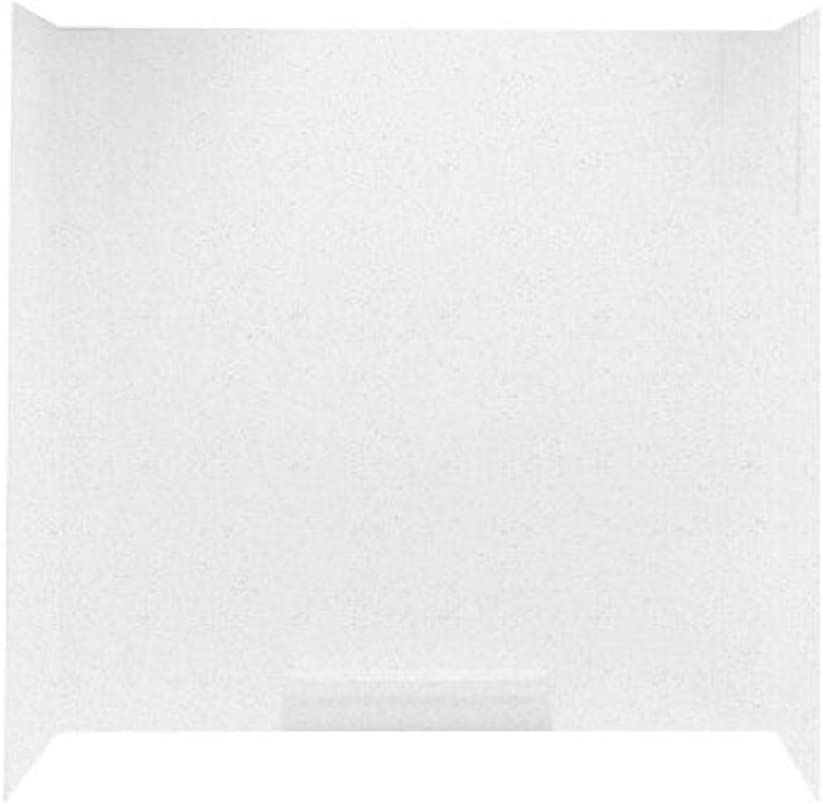
This kit is an excellent choice for those looking for an affordable and easy-to-install option for their bathtub walls. Here are the pros and cons of this product:
Pros:
- The panels are made of Veritek, a material that does not have a surface coating to chip or crack, making it very durable over time.
- The kit comes with one back panel with a molded-in soap dish and two end panels that can fit 30-in D x 60-in W (or smaller tub area) x 58-in H, which provides a perfect fit for many bathtub sizes.
- This kit is an ideal option for both remodeling and new construction projects, as the panels can be glued up over an existing surface, which makes installation easier and more efficient.
- This product is an affordable option compared to other bathtub wall kits on the market.
- The panels are easy to install, making it a good choice for those who want to tackle the project themselves.
- The product ships promptly and arrives well-packaged, ensuring that it arrives in good condition.
Cons:
- One customer reported that the back panel had some warpage that caused it to not lay completely flat against the wall, which required additional work to fix.
- One customer found the panels to be thinner than they expected, but noted that it was a good option for an investment property.
- Another customer mentioned that they did not need to order the corner trim as the side panels had a 90-degree vertical bend that extended 6 inches onto the back wall, which made the corner trim unnecessary.
Overall, the Swanstone Veritek Glue-Up 3-Panel Bathtub Wall Kit is an excellent option for those looking for a durable, affordable, and easy-to-install bathtub wall kit. While there were some minor issues reported by customers, they did not significantly detract from the overall quality of the product. This kit is a great choice for those looking for a cost-effective way to update the look of their bathtub.
4. Transolid Expressions 3-Panel Shower Wall Kit
The Transolid Expressions 3-Panel Shower Wall Kit is a versatile and easy-to-install solution for anyone looking to update their shower walls. The kit comes with a 3-piece wall surround, 2 inside corner trim pieces, and 4 tubes of silicone adhesive, providing everything you need for a hassle-free installation.
Pros:
- Easy to install: The kit comes with everything you need, including the 3-piece wall surround, 2 inside corner trim pieces, and 4 tubes of silicone adhesive. It can be cut to size and will glue right over an existing surface, making installation a breeze.
- Beautiful, smooth surface: The panels feature a smooth surface that is not only aesthetically pleasing but also easy to clean.
- Factory-finished outside edges: The outside edges of the wall panels are factory-finished, which means you don’t need to add extra trim to get a finished look.
- High-quality material: The panels are made of high-quality material that is durable and long-lasting.
- Great value: The price of this kit is significantly lower than other similar products on the market, making it a great value for those on a budget.
Cons:
- Lack of instructions: The kit doesn’t come with any instructions on installation, which can make it difficult for some users.
- Adhesive not included: While the product description states that the kit comes with 4 tubes of silicone adhesive, some users have reported that they did not receive any adhesive with their kit.
- Difficulty cutting panels: Some users have reported difficulty cutting the panels, which may require the use of a fine-toothed circular saw and multiple blades.
- Packaging issues: Some users have reported that the packaging can cause minor damages to the edges of the panels during transportation.
Overall, I am very satisfied with the Transolid Expressions 3-Panel Shower Wall Kit. It is a great value for the price and provides a beautiful and durable solution for shower renovations. While the lack of instructions and adhesive, as well as the difficulty cutting the panels, can be frustrating for some users, the overall quality and value of the product make it worth considering for anyone looking to renovate their bathroom.
XIX. Conclusion
In conclusion, bathtub and shower wall panels are a great option for those looking for a low-maintenance, waterproof surface to cover the walls around their tub or shower. In this article, we discussed various options for covering bathroom walls and explained why wall panels are a superior choice. We also defined terms like “bathtub surround,” “bathroom wall panels,” “bath side panel,” and “tub wrap.” Additionally, we compared different materials used for bathtub surrounds, explained how to install wall panels, and provided answers to common questions such as the lifespan of an acrylic tub surround and the cost of tub wraps. Overall, wall panels offer a durable, cost-effective, and easy-to-install solution for covering bathtub and shower walls, and we encourage readers to consider this option for their next bathroom renovation project.

